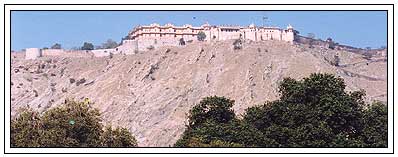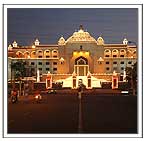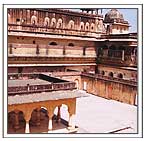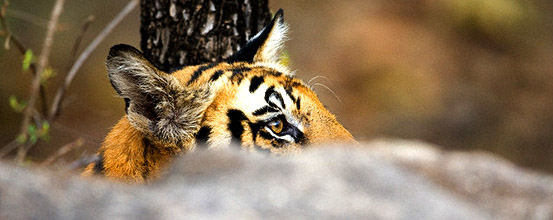Jaipur is the capital of Rajasthan state in west India. The second largest
Indian state of Rajasthan is a land of contrasts – the Thar Desert, mountains,
man- made and holy lakes, forests and jungles, impregnable fortresses and
magnificent palaces, of warrior kings and princes, saints and mystics, Rajputs
and Mughals. In common with other parts of India, Rajasthan has a wealth of
royal residences and stately homes in the form of palaces (great and small),
forts, hunting lodges or large estates.

In Rajasthan you can literally live like a king (or queen)
at the states 90 heritage properties castles, palaces, forts, and ornate havelis
that are converted into hotels or just entertain paying guests.
History
The Pink City of Jaipur dates back in time, to the reign of Maharaja Sawai
Jai Singh II, of the great warrior astronomer King of the Kachhwaha Rajput
clan. The city was designed by Sawai Jai Singh and his architect Vidyadhar
Bhattacharya only because it became impossible to fit the growing population
and supply them with good clean drinking water at Amber (which is about 11
kilometres from Jaipur), their home at that time.
It was in 1727 that Jaipur was founded using the principles of Shilpa
Shastra and thus becoming the first planned city of India. The city
follows grid system with wide straight roads, streets and lanes. One can
find uniform rows of shops on either side of main roads. As a security
measure from external aggression, the city was en-circled with a strong
wall with seven gates. It’s thus impossible to get lost here.
The pink color was used at the time of creating the city to create an
impression of red sandstone buildings similar to the Mughal cities. The
city was later repainsted pink in 1876, during the visit of the Prince of
Wales
What to see
City Palace or Sawai Jai Singh's Chandra Mahal (Moon Palace)
A delightful blend of Mughal and traditional Rajasthani architecture,
the City Palace sprawls over one-seventh of the area in the walled city.
It houses the Chandra Mahal, Shri Govind Dev Temple and the City Palace
Museum.
The City Palace is a historic landmark. The carved
arches are supported by grey-white marble columns studded with floral
motifs in gold and coloured stones. Two elephants carved in marble guard
the entrance, where retainers whose families have served generations of
rulers are at hand to serve as guides.
The palace interior
houses a Museum containing select collection of various types of
Rajasthani dresses, a fascinating armoury of Mughal and Rajput weapons;
swords of all shapes and sizes, with chased handles, some of them inlaid,
enamelled, encrusted with jewels and encased in bold and magnificent
scabbards.
It also has an art gallery with a fine collection of
paintings, carpets, royal paraphernalia and rare astronomical works in
Arabic, Persian, Latin and Sanskrit, acquired by Sawai Jai Singh-II for
his study of planets and their movements. Open: 9.30 am to 5pm.
The Maharani's Palace
Strangely enough the palace of the Queen, now houses the huge display of the
Rajput weaponry. And amongst the hundreds of weapons on display here, is one
of the most remarkable and deadly piece -- the scissor-action dagger. A fine
piece of mechanics: the weapon when thrust into the body, spreads its blades,
tearing away the insides completely at the time of being pulled out of the
body. A gruesome weapon to use. The armory collection is certainly not for
the weak hearted.
The other interesting parts of the Queens Palace are the walls and ceilings
with frescoes and gold inlayed art.

As you go further you come to the Diwan- E- Am, which used to be the hall
for public audience. This is now a vibrant art gallery showcasing the best
Hindu art like precious and ancient hand written Hindu manuscripts, delicate
miniature paintings in Rajasthani, Mughal and Persian schools on various themes
including the Ramayana and Mahabarata. The palace has well maintained gardens
all along, complete with a full range of fountains and well laid out pathways.
The palace is open for visitors from 9.30 am to 5.30pm daily.
Jal Mahal
Also known as Water Palace, built in the mid
18th century by Madho Singh I The Palace was developed as a pleasure spot
and was used for the royal duck shooting parties. A causeway leads to Jal
Mahal Palace situated in the middle of Man Sagar Lake, opposite the
cenotaphs.
Jantar Mantar
Next to city palace
The
early-18th-century Jantar Mantar, a stone observatory is the largest and
best preserved of the five observatories built by astronomer prince Jai
Singh II in different parts of the country. This observatory consisting of
outsized astronomical instruments is still in use. .
The stone and marble instruments whose settings and shapes are precisely
and scientifically designed represent the high points of Medieval Indian
astronomy. The Ram Yantras used for gauging altitudes are unique in their
isolation. this is the largest of the five observatories founded by Sawai
Jai Singh-II in various parts of the country.
Hawa Mahal
The ornamental facade of this "Palace of
Winds" is a prominent landmark in Jaipur. The five-storey structure
of sandstone is plastered pink, encrusted with fine trelliswork and
elaborates balconies. The palace has 953 niches and windows. Built in 1799
by Pratap Singh, the Mahal was a royal grandstand for the palace women.
It was conceived to provide adequate vantage position behind delicate
stone carved jali screens to the palace women for watching the royal
processions passing through the bazaar below.
Statue Circle
This is a traffic roundabout In Jaipur. The
Statue Circle is not only the most famed circle, but also the most
crowded. It is the favorite lounge of Jaipur and a place for evening out,
with 'Meals on Wheels' standing by. Strangely it acquires its name of
Statue Circle after its figurine rather -- the statue of Sawai Jai Singh
the founder of modern day Jaipur who stands there holding out astrological
diJaipurms to exemplify his proclivity for astrology. The lighting and the
colorful fountains cheer up the roundabout and its surrounds. You do not
have to make a special visit to this circle, you will pass this circle
almost everyday!
Amber Fort Palace
Amber is the classic romantic Rajasthani fort palace. Its construction was
started by Man Singh I in 1592, and completed by his descendent Jai Singh
I. Its forbidding exterior belies an inner paradise where a beautiful fusion
of Mughal and Hindu styles finds it's ultimate expression.

Amer Fort
Amber (Amer) is situated about 11 kilometers from
Jaipur and was the seat of the ruling Kachhawa kings, before they created
Jaipur. The Amber Fort itself is a fascinating blend of Hindu and Mughal
architecture made in red sandstone and white marble. The interior wall of
the palace abounds in paintings, carvings and mirror settings. Make sure
you visit the Maota Lake just outside the fort, it has a breathtaking
view. The Jai Mandir is here too, go there to check out the famous Sheesh
Mahal, the intricacies of the inlaid panel and dazzling mirror ceilings
are worth the visit. Your trip here would be even more exciting if you can
catch a ray of light playing magic in these rooms. A good time to go here
is early mornings.
Jaigarh Fort
The western skyline is dominated by the
extensive parkotas (walls), watch-towers and gateways of jaigarh. It is
one of the few military structures of mediaeval India preserved almost
intact containing palaces, gardens, open and covered reservoirs, a
granary, an armoury, a well-planned cannon foundry, several temples, a
tall tower and a giant mounted cannon-the Jai Ban - the largest in the
country.
Nahargarh Fort
Nahargarh Fort (meaning abode of the
tigers) overlooks the city and presents a glittering view of the city
lights by dusk. The fort has a unique cluster of 12 identical suits for
queens with a suit for the king himself at the head. During the peaceful
days, the fort used to be an excursion point for the royal family. The
fort retains some delicate frescoes too, guess where they’re placed
-- in the toilets. It’s believed that the royalty picnicked here,
well now you can too.
Albert Hall –Museum
This combined English and North
Indian architecture building is very well maintained. It has a good
collection of paintings, carpet, ivory, stone and metal sculptures and
colourful crystal works on display.
Gaitore
The final resting place befitting the Kings. That
is Gaitore about 6kms, off the Jaipur-Amber road. Situated in a narrow
valley the cenotaphs of the former Maharajas are chhatris made in typical
Rajput architecture. The chhatri of Sawai Jai Singh II is a work of art
with its typical Rajput architecture.
Sisodia Rani ka Bagh (8 kms away on Jaipur-Jaipur Road )
The
garden is laid in Mughal style depicts the legends of Radha and Krishna.
It consists of tiered multi-level gardens with fountains, watercourses and
painted pavilions. The palace house has several galleries, pavilions and
beautiful murals depicting scenes from the life of lord Krishna.
Kanak Vrindavan
This garden is best visited in the
monsoons when it is back to its clean green glory. Kanak Vrindavan is an
exquisitely landscaped garden with beautifully carved temple in beige
stone, with terrace sites all around and intricately carved marble columns
and lattices. This complex is a popular spot for picnic and more often
than not parts of the garden will be cordoned off due to film shoots.
Getaways
Sanganer (12 km on Tonk
Road)
It has beautiful Jain temples and important craft
industries besides the ruined monuments. Large and small units of block
and screen printers produce some of the finest hand printed textiles in
the country.
Bagru (35 km south west on Ajmer road)
The ground level
fort is still in good shape. Its main attraction is hand printed cloth
industry. The designs are simpler here, the techniques less complicated
and the colours are of earthy shades.
Ramgarh Lake (32 km north-east)
It is famous for its huge
artificial lake created by constructing a high bund amidst tree covered
hills. The temple of Jamwa Mata and some ruins of the old fort can also be
seen.
Samod (40 km north-west)
The old palace renovated and
rebuilt provides the most gorgeously decorated and painted examples of
Rajput haveli architecture.
Bairath (86 km on the Shahpura-Alwar road )
The excavated
remains of a circular Buddhist temple, unique in Rajasthan and the
earliest structural temple in India, make it an important historical
place. It also has monuments of Mughal and Rajput periods. Emperor Akabar
constructed mint and his son Jahangir created a beautiful Mughal garden
and a remarkable monument with painted chatris and walls here are of
significance.
Sambhar (94 km west )
It is the country's largest inland
salt lake. Sambhar lake known for the illusion ( mirage ) it gives at noon
times. It also has holy Devayani tank, beautiful Shakambhari Devi temple
and a palace.
Ranthambhore National Park
At eastern edge of the Thar
Desert ,145km from Jaipur. The park stretches across an area of 404 sq km
and is one of the last sanctuaries of the big cat, the Royal Bengal Tiger.
Tigers, panthers, wild cats, hyena, jackal, marsh crocodiles, wild boar,
bears, many species of deer and a rich birdlife of over 300 species,
including the great Indian horned owl are other species spotted here.
Sariska Tiger Reserve (100 km from Jaipur)
This has dry
deciduous forests, sheer cliffs and a rocky landscape interspersed with
the ruins of medieval buildings providing an appropriate setting for many
animals especially the majestic Royal Bengal tiger. Apart from the tiger,
a variety of deer including herds of sambar, chital, nilgai, four-horned
antelope, wild boar, hyena and jungle cats are found in the park. The best
time to visit the park is between February and June.
Tonk
Located 96 kms away from Jaipur this quiet town, was
ruled by the Pathan tribe from Afghanistan. Constructed around the Suneri
Kothi (Golden Bungalow), this town still retains a bit of Arabic and
Persian art. It is a place to pick up a good bargain in leather goods.
Gaitor
The cenotaphs of the royal family are at Gaitor,
just outside the city walls. The cenotaph of Maharaja Jai Singh II is
particularly impressive. The cenotaphs of the maharanis of Jaipur are on
Ambr road, midway between Jaipur and Amber. Nearby is the Jal Mahal (water
Palace), in the middle of the lake and reached by a causeway.
Galta
The temple of the sun god at Galta is 100m above
Jaipur to the east, a 2.5km climb from Surajpol. A deep, temple-studded
gorge stands behind the temple and there are good views over the
surrounding plains.
Chokhi Dhani
Near Jaipur airport
Chokhi Dhani, an
ethnic village resort with a blend of rustic environment and modern
amenities makes it your favorite destination in Pink City. Chokhi Dhani
Resort literally meaning the "Fine Hamlet" is a 5 star Ethnic
resort, the only one of its kind in the country. With quaint mud and
thatch dwellings set in sprawling acreage of land, it serves ethnic
Rajasthani vegetarian cuisine. Traditional folk performance is organised
alongside.
Dining Out
The deluxe hotels in Jaipur have elegant restaurants, bars and cafes
that serve an eclectic mixture of Indian, Asian and European cuisines in a
beautiful ambience. The Mirza Ismail Road is the main thoroughfare that
has a number of mid range eating places which serve good food in clean
surroundings. For really inexpensive food, especially if you are not too
particular about the general hygiene and cleanliness, try the Station Road
with its many ‘dhabas’ or small roadside restaurants.
Most hotels organize theme evenings especially during the tourist season
and these can be rather charming. Otherwise, entertainment options are
limited to cinema houses that screen the latest Hindi movies and Hollywood
blockbusters or the occasional cultural performances.
Nightlife
The Polo Bar
Decorated with polo trophies won by the late Maharaja of Jaipur, it is
rated amongst the finest bars in the world.
Steam, at the same hotel is located in a very unique setting of a steam
engine. It is Jaipur's first and original "pub on wheels". is a
popular watering hole. Rambagh Palace hotel, Bhawani Singh Road,
Geoffrey's
The hotel pub delights you with a wide range of
delectable dishes and wines on its menu.
The Park Plaza Hotel,
Prithviraj Road
Apna Gaon
Serves authentic local cuisine amidst recreated
village atmosphere. Entertainment here comes from puppet shows and folk
dances. Most delicacies served here are made from vegetables grown on the
same farm. Jaipur Sikar Road.
Shopping
Jaipur is a treasure trove of shopping. It is a major gems and
jewellery centre. Marble statues, woolen carpets, hand printed Sanganeri
and Bagru cotton fabrics, brassware, blue pottery made from crushed
quartz, leather footwearand cotton rugs make popular local merchandise
here.
M.I.Road has many upmarket handicraft stores. Johri bazaar (jeweller's
market), near Hawa Mahal has some of the best trinkets, enamel jewellery
and uncut precious stones. Shops at Chhoti Chaupar sell traditional
skirts, bags, turbans, light quilts, carpets, embroidered shoes (jootis)
and other objects. Artisans at work can be seen at many places in the
city.
One can buy Jaipur's famous blue pottery at Kripal Singh Shekhawat's
studio that has revived the tradition of blue pottery, on Shiv Marg in
BaniPark area.
Markets are generally open from 10:30 am till 5:30 pm and are closed on
Sundays. Rajasthan Cottage Industries at Shilpgram Complex, GolomarGarden
sells a wide range of silver jewellery, furniture, textiles and hand made
paper.
Visiting
Jaipur has extreme climates. The temperatures soar to as high as
47 degree Celsius during the summer and fall to about 4 degree Celsius
during the winter. The ideal time to plan a trip to Jaipur would be
between October and April.
Tourist
Offices
Rajasthan Tourism department’s offices
(RTDC) are located in the Paryatan Bhavan, on the main thoroughfare Mirza
Ismail Road, Tel# 376362. RTDC has counters at the railway station and bus
station as well. The Government of India’s tourist office is in the
Hotel Khasa Kothi, Tel# 315461.
How to
get there
Air
The Sanganer Airport is 12 km
out of the city. It is well connected to all major cities in the country.
There are regular flights to Mumbai, Udaipur, Kolkatta and New Delhi from
here. On the international route there is a flight to Dubai daily.
Rail
The railway station, is situated in the heart of the
city and has trains chugging out to all major cities like Mumbai, New
Delhi, Chennai and Kolkatta. The Palace on Wheels is the best option to
travel to this royal city. It would an expensive trip, but the experience
on the train makes it all worth it.
Road
Jaipur is linked by the National Highways 8 and 11.
The national highway number 8 links Jaipur directly to New Delhi and 11
links Jaipur to Jaipur. There are regular bus services to Jaipur (230 km) and
Delhi (261 km). The journey is quite decent by road saving a few bad
patches. And there’s some awesome food on the way too, stop at any of
the dhaba’s and get your first bite of dhal-bhatti and puran poli









